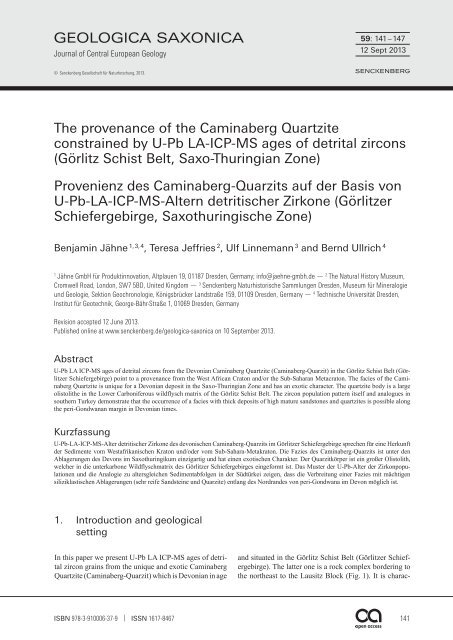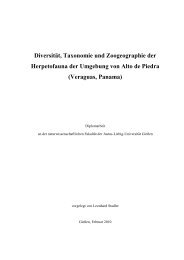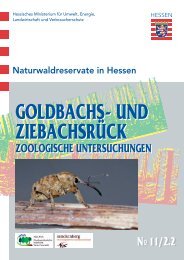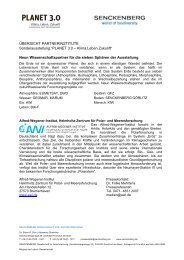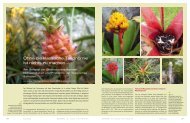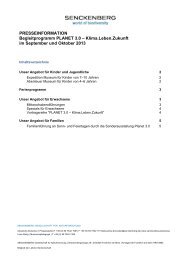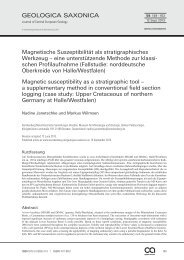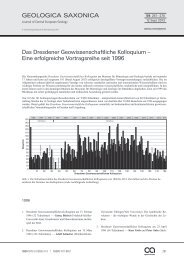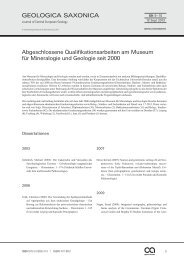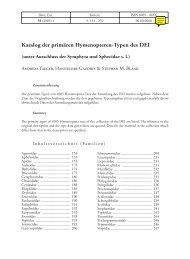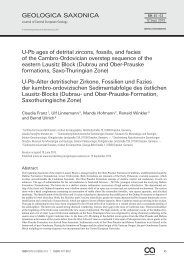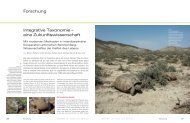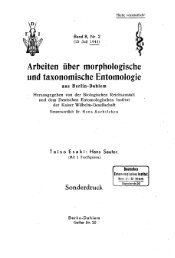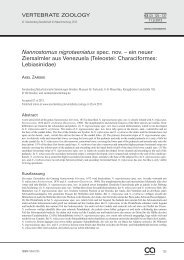Görlitz Schist Belt, Saxo-Th - Senckenberg Museum
Görlitz Schist Belt, Saxo-Th - Senckenberg Museum
Görlitz Schist Belt, Saxo-Th - Senckenberg Museum
Create successful ePaper yourself
Turn your PDF publications into a flip-book with our unique Google optimized e-Paper software.
59: 141 – 147<br />
12 Sept 2013<br />
© <strong>Senckenberg</strong> Gesellschaft für Naturforschung, 2013.<br />
<strong>Th</strong>e provenance of the Caminaberg Quartzite<br />
constrained by U-Pb LA-ICP-MS ages of detrital zircons<br />
(<strong>Görlitz</strong> <strong>Schist</strong> <strong>Belt</strong>, <strong>Saxo</strong>-<strong>Th</strong>uringian Zone)<br />
Provenienz des Caminaberg-Quarzits auf der Basis von<br />
U-Pb-LA-ICP-MS-Altern detritischer Zirkone (<strong>Görlitz</strong>er<br />
Schiefergebirge, <strong>Saxo</strong>thuringische Zone)<br />
Benjamin Jähne 1, 3, 4 , Teresa Jeffries 2 , Ulf Linnemann 3 and Bernd Ullrich 4<br />
1<br />
Jähne GmbH für Produktinnovation, Altplauen 19, 01187 Dresden, Germany; info@jaehne-gmbh.de — 2 <strong>Th</strong>e Natural History <strong>Museum</strong>,<br />
Cromwell Road, London, SW7 5BD, United Kingdom — 3 <strong>Senckenberg</strong> Naturhistorische Sammlungen Dresden, <strong>Museum</strong> für Mineralogie<br />
und Geologie, Sektion Geochronologie, Königsbrücker Landstraße 159, 01109 Dresden, Germany — 4 Technische Universität Dresden,<br />
Institut für Geotechnik, George-Bähr-Straße 1, 01069 Dresden, Germany<br />
Revision accepted 12 June 2013.<br />
Published online at www.senckenberg.de/geologica-saxonica on 10 September 2013.<br />
Abstract<br />
U-Pb LA ICP-MS ages of detrital zircons from the Devonian Caminaberg Quartzite (Caminaberg-Quarzit) in the <strong>Görlitz</strong> <strong>Schist</strong> <strong>Belt</strong> (<strong>Görlitz</strong>er<br />
Schiefergebirge) point to a provenance from the West African Craton and/or the Sub-Saharan Metacraton. <strong>Th</strong>e facies of the Caminaberg<br />
Quartzite is unique for a Devonian deposit in the <strong>Saxo</strong>-<strong>Th</strong>uringian Zone and has an exotic character. <strong>Th</strong>e quartzite body is a large<br />
olistolithe in the Lower Carboniferous wildflysch matrix of the <strong>Görlitz</strong> <strong>Schist</strong> <strong>Belt</strong>. <strong>Th</strong>e zircon population pattern itself and analogues in<br />
southern Turkey demonstrate that the occurrence of a facies with thick deposits of high mature sandstones and quartzites is possible along<br />
the peri-Gondwanan margin in Devonian times.<br />
Kurzfassung<br />
U-Pb-LA-ICP-MS-Alter detritischer Zirkone des devonischen Caminaberg-Quarzits im <strong>Görlitz</strong>er Schiefergebirge sprechen für eine Herkunft<br />
der Sedimente vom Westafrikanischen Kraton und/oder vom Sub-Sahara-Metakraton. Die Fazies des Caminaberg-Quarzits ist unter den<br />
Ablagerungen des Devons im <strong>Saxo</strong>thuringikum einzigartig und hat einen exotischen Charakter. Der Quarzitkörper ist ein großer Olistolith,<br />
welcher in die unterkarbone Wildflyschmatrix des <strong>Görlitz</strong>er Schiefergebirges eingeformt ist. Das Muster der U-Pb-Alter der Zirkonpopulationen<br />
und die Analogie zu altersgleichen Sedimentabfolgen in der Südtürkei zeigen, dass die Verbreitung einer Fazies mit mächtigen<br />
siliziklastischen Ablagerungen (sehr reife Sandsteine und Quarzite) entlang des Nordrandes von peri-Gondwana im Devon möglich ist.<br />
1. Introduction and geological<br />
setting<br />
In this paper we present U-Pb LA ICP-MS ages of detrital<br />
zircon grains from the unique and exotic Caminaberg<br />
Quartzite (Caminaberg-Quarzit) which is Devonian in age<br />
and situated in the <strong>Görlitz</strong> <strong>Schist</strong> <strong>Belt</strong> (<strong>Görlitz</strong>er Schiefergebirge).<br />
<strong>Th</strong>e latter one is a rock complex bordering to<br />
the northeast to the Lausitz Block (Fig. 1). It is charac-<br />
ISBN 978-3-910006-37-9 | ISSN 1617-8467<br />
141
SB<br />
B. Jähne et al.: <strong>Th</strong>e provenance of the Caminaberg Quartzite<br />
Torgau-Doberlug<br />
Syncline<br />
CB<br />
LG<br />
RR<br />
CG<br />
GGC<br />
Lausitz-Leipzig<br />
Greywacke Complex<br />
WLF<br />
WB<br />
LAUSITZ BLOCK<br />
PH<br />
Kamenz<br />
14°30´<br />
HD<br />
MLF<br />
51°30´<br />
ILF<br />
GSG<br />
Sample Ho1<br />
Quarry Horscha<br />
High mature sandstone<br />
Devonian<br />
0 10 20 30<br />
km<br />
PL<br />
<strong>Th</strong>e Lausitz Block<br />
and adjoining areas<br />
MSF<br />
N<br />
Germany<br />
7<br />
6<br />
5<br />
4<br />
3<br />
2<br />
1<br />
MM<br />
NWSG<br />
Cadomian<br />
basement<br />
10<br />
9<br />
8<br />
Dresden<br />
DG<br />
WG<br />
ETSG<br />
Lausitz Granitoid Complex <strong>Görlitz</strong><br />
LAUSITZ BLOCK<br />
13<br />
12<br />
11<br />
LT<br />
Decin<br />
D<br />
Elbe Zone<br />
15<br />
14<br />
17<br />
16<br />
KD<br />
CZ<br />
Linnemann 2007<br />
ISF<br />
Jizera<br />
Karkonosze Block<br />
SKMC<br />
Jelenia Gora<br />
Trutnov<br />
KMC<br />
SUDETES<br />
FSB<br />
Walbrzych<br />
Fig. 1. Geological map of the Lausitz Block (<strong>Saxo</strong>-<strong>Th</strong>uringian Zone) including deposits of the Lausitz-Leipzig Greywacke Complex<br />
(Lausitz-Leipziger Grauwackenkomplex, latest Ediacaran to Early Cambrian age), Early Cambrian intrusions of the<br />
Lausitz Granitoid Complex (Lausitzer Granodioritkomplex), and geological units of adjoining areas (after Linnemann et al.<br />
2008, Kozdrój et al. 2001, Linnemann & Schauer 1999, Linnemann et al. 2010a, b). Geochronological ages are taken from:<br />
* Buschmann et al. 2001 (SHRIMP U-Pb), ** Linnemann et al. 2007 (U-Pb on single zircons by LA-ICP-MS), *** Linnemann<br />
et al. 2000 (Pb-Pb evaporation age on single zircons), **** Linnemann, McNaughton, Drost, Gehmlich, Tonk – unpublished<br />
data (SHRIMP U-Pb).<br />
1, Rothstein Formation (Ediacaran, c. 566 Ma) with sedimentary deposits, black cherts, and volcanic rocks from a Cadomian<br />
back-arc basin in the Torgau-Doberlug Syncline; 2, Diamictites intercalated with Ediacaran passive margin deposits (greywackes,<br />
quartzites, quartz shists, shales) of the Weesenstein Group (Elbe Zone) and the Clanzschwitz Group (North <strong>Saxo</strong>n Anticline);<br />
at Kunnersdorf near <strong>Görlitz</strong>, there is a small diamictite occurrence in the Lausitz Block; 3, Lausitz Group, consisting of monotonous<br />
greywacke-schist turbidites that formed in the setting of a retro-arc or foreland basin, respectively (latest Ediacaran to<br />
earliest Cambrian); 4, Microconglomerate intercalated into the Lausitz Group and mainly composed of fragments of black chert;<br />
5, Early Cambrian intrusions of granodiorites, granites, diorites, and tonalites of the Lausitz Granitoid Complex and adjoining<br />
areas (c. 540 – 530 Ma); 6, Late Ediacaran sedimentary rocks and Early Cambian granitoid intrusions often strongly sheared and<br />
metamorphosed under upper greenshist to amphibolite facies conditions; 7, Late Ediacaran sedimentary rocks strongly sheared<br />
and metamorphosed under upper greenshist to amphibolite facies conditions (units of the Erzgebirge Block bordering on the Elbe<br />
Zone); 8, Lower to Middle Cambrian deposits; 9, A few gigantic Lower Cambrian blocks in a Lower Carboniferous wildflysch<br />
deposit; 10, Lower Ordovician high mature conglomerates, sandstones, and shales (Tremadoc); 11, Lower Ordovician granitoids<br />
(c. 490 – 480 Ma); 12, Cambro-Ordovician, Silurian, and Lower Carboniferous sedimentary rocks and volcano-sedimentary complexes<br />
affected by the Variscan Orogeny (undifferentiated); 13, Variscan granitoid intrusions (c. 335 – 300 Ma); 14, Variscan early<br />
molasse in Upper Viséan units of the Torgau-Doberlug Syncline; 15, Molasse deposits and volcanic rocks in Upper Carboniferous<br />
and Lower Permian basins; 16, Meso- and Cenozoic cover rocks; 17, Tertiary basalts.<br />
CG, Clanzschwitz Group (Ediacaran); LG, Laas Granodiorite (Early Cambrian); WG, Weesenstein Group (Ediacaran); DG,<br />
Dohna Granodiorite (Early Cambrian); GGC, Großenhain Gneiss Complex originated from Cadomian basement rocks containing<br />
Ediacaran pararocks and orthogneisses of Early Cambrian age; RR, Rothstein Rock (type area of the Rothstein Formation,<br />
Ediacaran); KD, Roadcut near the village of Kunnersdorf (occurrence of a diamictite, Lausitz Group, Ediacaran); WB, Wetterberg<br />
Mountain with a quarry near the village of Ebersbach (occurrence of a microconglomerate containing black cherts, Lausitz Group,<br />
Ediacaran); PH, village of Petershain (occurrence of a microconglomerate containing black cherts, Lausitz Group, Ediacar an);<br />
CB, Collmberg Mountain (type area of the Collmberg Formation, Tremadoc); HD, Area of the Hohe Dubrau (type area of the<br />
Dubrau Formation, Tremadoc); NWSG, Nossen-Wilsdruff <strong>Schist</strong> <strong>Belt</strong> (Variscan schist belt, part of the complex dextral shear-zone<br />
system of the Elbe Zone); ETSG, Elbtal <strong>Schist</strong> <strong>Belt</strong> (Variscan schist belt, part of the complex dextral shear-zone system of the<br />
Elbe Zone); GSG, <strong>Görlitz</strong> <strong>Schist</strong> <strong>Belt</strong> (Variscan wildflysch complex bordering to the north of the Lausitz Block); SKMC, South<br />
Karkonosze Metamorphic Complex; KMC, Kaczawa Metamorphic Complex; FSB, Fore Sudetic Block; SB, Sowie Mountains<br />
Block; MM, Meissen Massif (Variscan complex of granitoids, c. 335 – 330 Ma); WLF, West Lausitz Fault; LT, Lausitz <strong>Th</strong>rust;<br />
MLF, Main Lausitz Fault; ILF, Intra Lausitz Fault; ISF, Intra Sudetic Fault; MSF, Marginal Sudetic Fault.<br />
Abb. 1. Geologische Karte des Lausitz-Blocks (<strong>Saxo</strong>thuringische Zone).<br />
terized by Lower Carboniferous wildflysch deposits of<br />
greywacke-mudstone turbidites, debris flows, and conglomerates<br />
with abundant olistoliths of Palaeozoic rock<br />
units (Fig. 2; Linnemann & Schauer 1999, Göthel 2001).<br />
With the exception of a number of quarries, the area is<br />
poorly exposed (“Terra Incognita” of Stille 1951) and<br />
mostly known from drill cores (Brause 1969). Some olistoliths<br />
are compatible with the <strong>Th</strong>uringian Facies. <strong>Th</strong>is is<br />
142
GEOLOGICA SAXONICA — 59: 2013<br />
318<br />
(Ma)<br />
359<br />
375<br />
398<br />
417<br />
422<br />
443<br />
461<br />
472<br />
488<br />
501<br />
513<br />
542<br />
Cambrian Ordovician Silur. Devonian Carbon.<br />
Lower<br />
Upper<br />
Middle<br />
Lower<br />
Upper<br />
Middle<br />
Lower<br />
Upper<br />
Middle<br />
Lower<br />
Sample Ho1<br />
Kieselschiefer-Hornstein-Konglomerat limestones (Kohlenkalke)<br />
cherts<br />
Fe<br />
Caminaberg Qt different drill cores* (schemat.):<br />
diabase, diabase tuff, cherts,<br />
Mönau Qt shales, quartzite, greywacke<br />
different drill cores*<br />
(schematic):<br />
intercalation of quartzites,<br />
sandstones, shales,<br />
carbonates, diabase,<br />
diabase tuffs and tuffites<br />
alum shale of<br />
Caminaberg and Weißkollm<br />
cherts of Pansberg and Ratzen<br />
Eichberg Sandstone<br />
Klitten Fm (drill core NSL 17/62 near Klitten)<br />
Charlottenhof Fm<br />
(L. Cambrian of<br />
Ludwigsdorf)<br />
Palaeozoic olistoliths in Lower Carboniferous wildflysch<br />
1 2 3 4 Fe 5<br />
6 7 8 9 10<br />
Fig. 2. Schematic lithologic column for the <strong>Görlitz</strong> <strong>Schist</strong> <strong>Belt</strong><br />
showing elements of both, the <strong>Th</strong>u ring ian and the Bavarian<br />
Facies (modified after Lin ne mann et al. 2010a). Except<br />
for the Lower Carboniferous chert-bearing conglomerate,<br />
all Palaeozoic rock bodies are interpreted as oli sto liths in<br />
a Lower Carboniferous wildflysch matrix (grey coloured<br />
triangle-pattern; modified after Brause 1969, Lin ne mann<br />
& Schauer 1999, Göthel 2001). * im por tant drill cores for<br />
Devonian strata: NSL 16/62 (Frie ders dorf), NSL 11/61<br />
(Litschen), NSL 7/62 (Kreba 1), NSL 15/62 (Halbendorf),<br />
NSL 19/63 (Lippen 1), NSL 32/63 (Reich walde), SP 38<br />
(Spremberg), NSL Uhyst, NSL 6/61 (Neu dorf). For details<br />
see Brause (1969) and Berger et al. (2008). 1, Conglomerate<br />
(Kieselschiefer-Hornstein-Konglomerat); 2, Quartzites<br />
and sandstones; 3, Shales and schists; 4, Alumn shales with<br />
graptolithes; 5, Chamositic sedimentary iron ore underlying<br />
the Caminaberg Quartzite; 6, Bedded cherts; 7, Dark<br />
grey carbon-rich limestone (Kohlenkalk); 8, Carbonates;<br />
9, Diabases; 10, Dia base tuffs and tuffites.<br />
Abb. 2. Schematisches Säulenprofil zur Darstellung der lithologischen<br />
Einheiten des <strong>Görlitz</strong>er Schiefergebirges.<br />
especially the case for the Lower Cambrian units of Ludwigsdorf<br />
and the Lower Silurian cherts and alum shales<br />
(Fig. 2). <strong>Th</strong>e Upper Silurian limestone (Ocker kalk) does<br />
not exist and is replaced by alum shales (Fig. 2). Typical<br />
elements of the Bavarian Facies are the chert-bearing<br />
conglomerate (Kieselschiefer-Hornstein-Konglomerat),<br />
Lower Carboniferous black limestones (Kohlenkalk),<br />
Upper Devonian cherts, and the Upper Ordovician Eichberg<br />
Sandstone (Eichberg-Sandstein), which could be an<br />
equivalent to the Döbra Sandstone (Döbra-Sandstein)<br />
of the Bavarian Facies (Fig. 2). Several Palaeozoic rock<br />
units in the <strong>Görlitz</strong> <strong>Schist</strong> <strong>Belt</strong> are exotic and not known<br />
from other parts of the <strong>Saxo</strong>-<strong>Th</strong>uringian Zone. <strong>Th</strong>ese are<br />
the Upper Devonian shallow-marine to terrestrial quartzites<br />
(Mönau-Quarzit, Caminaberg-Quarzit) and sedimentary<br />
iron ores (Fig. 2). Göthel (2001) suggested the formation<br />
of an accretionary prism north of the Lausitz<br />
Block during the Early Carboniferous to explain the situation.<br />
<strong>Th</strong>e <strong>Görlitz</strong> <strong>Schist</strong> <strong>Belt</strong> continues to the Sudetes<br />
(Bober-Katzbach-Gebirge; Fig. 1).<br />
2. Analytical techniques<br />
2.1. Zircon separation<br />
Zircon concentrates were separated at the <strong>Senckenberg</strong><br />
Naturhisto ri sche Sammlungen Dresden, <strong>Museum</strong> für Mi -<br />
ne ralogie und Geologie. 1 kg samples of unweathered<br />
sand stone were crushed and sieved and then a heavy mineral<br />
separate was concentrated by use of a heavy liquid<br />
(lithium heteropolytungstate in water). A final concentration<br />
was made by magnetic separation in a Frantz isodynamic<br />
separator. Selection of the zircon grains for U-Pb<br />
dating was achieved by hand-picking under a binocular<br />
microscope. Zircon grains of all grain sizes and morphological<br />
types were selected for single grain analyses by<br />
LA-ICP-MS. Zircon crystals were set in synthetic resin<br />
mounts, polished to approximately half their thickness,<br />
and clean ed in a warm, dilute nitric acid (HNO 3 ) ultrasonic<br />
bath followed by rinsing in de-ionised water.<br />
2.2. LA-ICP-MS U-Pb dating<br />
U-Pb age of single grains was determined by LA-ICP-<br />
MS at the Natural History <strong>Museum</strong> (London) using a<br />
New-Wave UP213 frequency quintupled solid-state<br />
Nd : YAG-laser (l = 213 nm) coupled to a PlasmaQuad 3<br />
quadrupole ICP-MS. Samples and standard were placed<br />
in an airtight chamber which was flushed by helium (He)<br />
gas carrying the ablated material to the ICP-MS, mixed<br />
with argon (Ar) prior to injection to the plasma torch.<br />
U-Pb and Pb-Pb ratios of the unknowns were determined<br />
relative to that of the 91.500 zircon standard with certified<br />
ID-TIMS ages of 1062.4 ± 0.4 Ma for 206 Pb/ 238 U<br />
and 1065.4 ± 0.3 Ma for<br />
207<br />
Pb/ 206 Pb. Collection of data<br />
spanned up to 180 s per analysis and includes a gas background<br />
taken during the initial c. 60 s. To reduce the extent<br />
of inter-element laser induced fractionation, the sample<br />
was moved relatively to the laser beam along a line.<br />
<strong>Th</strong>e nominal diameter of the laser beam was 60 μm for<br />
the standard and 30 μm or 45 μm for the unknowns. Pulse<br />
energy of the laser was 0.03 – 0.06 mJ per pulse for the<br />
unknowns and 0.09 mJ per pulse for the standard with an<br />
energy density of 3.5 J/cm 2 and a repetition rate of 20 Hz.<br />
Further discussion of the analytical protocols used in this<br />
study can be found in Fernández-Suárez et al. (2002).<br />
Raw data reduction was performed using LAMTRACE,<br />
a macro based spreadsheet written by Simon Jackson<br />
143
B. Jähne et al.: <strong>Th</strong>e provenance of the Caminaberg Quartzite<br />
Probability Probability Probability<br />
Probability Probability Probability<br />
0.45<br />
206 Data-point error ellipses are 2σ<br />
Pb<br />
0.45<br />
206 238 Data-point error ellipses are 2σ<br />
Pb U<br />
2000<br />
0.35<br />
0.45<br />
238 U<br />
206 Data-point 2000 error ellipses are 2σ<br />
1000<br />
0.35 Pb<br />
238 0.16<br />
1600<br />
1.8<br />
U<br />
900 1000<br />
2000<br />
0.25<br />
0.14<br />
0.16<br />
0.35<br />
1600<br />
1.6<br />
800<br />
1.8<br />
900<br />
0.25<br />
1200<br />
0.12 0.14<br />
1.4 1000 1.6<br />
700 800<br />
0.16<br />
1600<br />
1.2<br />
1200<br />
1.4<br />
1.8<br />
900<br />
0.15<br />
0.10 600 0.12<br />
700<br />
0.25 800<br />
1.0 0.14<br />
1.2<br />
1.6<br />
800<br />
500<br />
0.15<br />
0.08 0.10 600<br />
0.8<br />
800 1200<br />
1.0<br />
1.4<br />
0.12<br />
700 a<br />
500<br />
400<br />
207 Pb/ 235 0.6<br />
0.08<br />
U<br />
0.8<br />
1.2<br />
0.05<br />
0.15<br />
0.10 600<br />
a<br />
0400<br />
800 2 4 207 6 8<br />
Pb/ 235 0.6<br />
1.0<br />
U<br />
0.05<br />
500<br />
0.08<br />
0 2 0.8 4 6 8<br />
0.012<br />
a 7<br />
400 Sample Ho 1<br />
207 Pb/ 235 0.6<br />
U<br />
0.05<br />
Caminaberg Quartzite<br />
0.012<br />
0.010<br />
<strong>Görlitz</strong> <strong>Schist</strong> <strong>Belt</strong><br />
b 67<br />
0 Sample 2 Ho 1 4 6 8<br />
(<strong>Görlitz</strong>er Caminaberg Schiefergebirge)<br />
Quartzite<br />
Devonian<br />
5<br />
0.008<br />
<strong>Görlitz</strong> <strong>Schist</strong> <strong>Belt</strong><br />
b 6<br />
0.010<br />
0.012<br />
White quartzite<br />
0.4–0.540 Ma: 4 %<br />
(<strong>Görlitz</strong>er Schiefergebirge)<br />
7<br />
n=50/60 Sample Ho 1<br />
0.541–0.99 Ga: 72 %<br />
Devonian<br />
45<br />
0.008<br />
85–115% Caminaberg conc. Quartzite 1.0–1.59 Ga: 14 0.006<br />
White quartzite<br />
0.4–0.540 Ma: 4 %<br />
<strong>Görlitz</strong> <strong>Schist</strong> <strong>Belt</strong><br />
1.6–2.49 10<br />
b 6<br />
0.010<br />
n=50/60<br />
0.541–0.99 Ga: 72 %<br />
34<br />
(<strong>Görlitz</strong>er Schiefergebirge) 2.5–3.5 0 85–115% conc.<br />
1.0–1.59 Ga: 14 %<br />
0.006<br />
0.004<br />
Devonian<br />
5<br />
0.008<br />
1.6–2.49 Ga: 10 White quartzite<br />
0.4–0.540 Ma: 4 %<br />
2.5–3.5 Ga: 0 23<br />
0.004<br />
n=50/60<br />
0.541–0.99 Ga: 72 % 4<br />
0.002<br />
85–115% conc.<br />
1.0–1.59 Ga: 14 %<br />
0.006<br />
12<br />
1.6–2.49 Ga: 10 %<br />
3<br />
0.002<br />
2.5–3.5 Ga: 0 %<br />
0.000<br />
01<br />
0.004<br />
2<br />
0.000<br />
0<br />
0.002<br />
Age (Ma)<br />
1<br />
0.014<br />
0.000<br />
0.012 0.014<br />
0.010 0.012<br />
0.014<br />
0.008 0.010<br />
0.012<br />
0.006 0.008<br />
0.010<br />
0.004 0.006<br />
0.008<br />
0.002 0.004<br />
0.006<br />
0.000 0.002<br />
0.004<br />
0.000<br />
0.002<br />
0.000<br />
400<br />
400<br />
400<br />
400<br />
400<br />
400<br />
500<br />
500<br />
500<br />
600<br />
600<br />
600<br />
500<br />
500<br />
500<br />
700<br />
700<br />
700<br />
800<br />
800<br />
565 Ma 565 Ma<br />
800<br />
565 Ma<br />
900<br />
900<br />
1000 1000<br />
595 Ma 595 Ma 595 Ma<br />
615 Ma 615 Ma<br />
900<br />
600<br />
600<br />
600<br />
1000<br />
1100<br />
1100<br />
640<br />
660 Ma<br />
640<br />
660 Ma<br />
615 Ma<br />
1100<br />
640<br />
660 Ma<br />
1200 1200<br />
700<br />
700<br />
(Macquarie University, Australia). Cal culations and plotting<br />
of concordia diagrams were achieved using Isoplot/<br />
Ex rev. 2.49 (Ludwig 2001), pro b ability density plots<br />
and histograms were prepared by AgeDisplay (Sircombe<br />
2004).<br />
1300 1300<br />
Age (Ma)<br />
1200<br />
700<br />
1300<br />
Age (Ma)<br />
Age (Ma)<br />
Age (Ma)<br />
Age (Ma)<br />
Fig. 3. U-Pb ages of detrital zircon grains from sample Ho1 (Cami<br />
naberg Quartzite, Devonian, <strong>Görlitz</strong> <strong>Schist</strong> <strong>Belt</strong>, <strong>Saxo</strong>-<br />
<strong>Th</strong>uringian Zone): a, Concordia diagram; b, Combined<br />
binn ed frequency and probability density distribution plots<br />
of detrital zircon grains in the range of 400 – 2200 Ma;<br />
c, Combined binned frequency and probability density distri<br />
bution plots of detrital zircon grains in the range of 400 –<br />
1100 Ma.<br />
Abb. 3. U-Pb-Alter detritischer Zirkone der Probe Ho1 (Caminaberg-Quarzit).<br />
1400 1400<br />
1400<br />
800<br />
800<br />
800<br />
1500 1500<br />
1500<br />
1600 1600<br />
1600<br />
1700 1700<br />
1700<br />
900<br />
900<br />
900<br />
1800 1800<br />
1800<br />
1900 1900<br />
1900<br />
1000 Ma 1000 Ma<br />
1000 Ma<br />
1000<br />
1000<br />
1000<br />
2000 2000<br />
2100 2100<br />
c<br />
c<br />
2000<br />
c<br />
2100<br />
2200 2200<br />
2200<br />
1100<br />
1100<br />
1100<br />
7<br />
0<br />
67<br />
56<br />
7<br />
45<br />
6<br />
34<br />
5<br />
23<br />
4<br />
12<br />
3<br />
01<br />
2<br />
0<br />
1<br />
0<br />
Frequency Frequency Frequency<br />
Frequency Frequency Frequency<br />
3. Results<br />
60 detrital zircon grains were analyzed from sample Ho1<br />
of the white and high mature Caminaberg Quartzite. For<br />
the coordinates of the sample location, see the heading<br />
of Tab. 1. U-Pb data are shown in Tab. 1 and Fig. 3. Of<br />
60 measured grains, 50 grains were concordant (in the<br />
range of 85 – 115%; Fig. 3). <strong>Th</strong>e youngest concordant<br />
grain is 502 ± 6 Ma old. <strong>Th</strong>e oldest zircon has an age<br />
of 2158 ± 19 Ma. <strong>Th</strong>e sample yields two Cambrian zircons<br />
(502 ± 6 Ma and 538 ± 6 Ma). 72% of all zircons<br />
in the sample are Neoproterozoic in age ranging from<br />
~ 546 – 896 Ma (Fig. 3, Tab. 1). 14% of all grains show<br />
Mesoproterozoic ages (~ 1022 – 1050 Ma). 10% of all<br />
zircons in the sample are Palaeoproterozoic in age in the<br />
range of ~ 1920 – 2158 Ma (Fig. 3, Tab. 1). No Archaean<br />
grains occur. <strong>Th</strong>e probability plot shows distinct peaks<br />
at ~ 565 Ma, 595 Ma, 615 Ma, 640 Ma, 660 Ma, and<br />
~ 1000 Ma (Fig. 3).<br />
4. Discussion and conclusion<br />
On the base of the U-Pb dating of the detrital zircon<br />
grains from the Caminaberg Quartzite a derivation<br />
of the clastic debris from the West African Craton or<br />
from the Sub-Saharan Metacraton is concluded in this<br />
paper. Typical for the provenance from the West African<br />
Craton in the pattern of detrital zircon spectra is a<br />
magmatic gap in the range of c. 1.0 – 1.6 Ga, peaks at<br />
c. 2.0 Ga and c. 2.5 Ga, and a few Archean ages (e.g,.<br />
Linnemann et al. 2011, Drost et al. 2010). Observations<br />
of zircon patterns derived from the Sub-Saharan Metacraton<br />
show distict peaks at ~ 0.9 – 1.2 Ga, 1.6 – 2.2 Ga,<br />
2.3 – 2.7 Ga, and 3.0 – 3.4 Ga (Altumi et al. 2013). All<br />
other continents, which are principal candidates for<br />
sediment supply during Ordo vician times (Baltica, Avalonia,<br />
Amazonia) show a very strong portion of Mesoproterozoic<br />
zircon grains (Nance & Murphy 1994, Keppie<br />
et al. 2003, Gerdes & Zeh 2006, Linnemann et al.<br />
2011). <strong>Th</strong>e relative lack of Meso pro terozoic zircons in<br />
the Caminaberg Quartzite completely rules out Baltica,<br />
Avalonia, and Amazonia as sources for the siliciclastic<br />
sediments of the Caminaberg Quartzite. Instead, the age<br />
patterns of detrital zircons from the Caminaberg Quartzite<br />
clearly indicate the fingerprint of the West African<br />
Craton and/or the Sub-Saharan Metacraton. <strong>Th</strong>e Devonian<br />
sediments of the investigated quartzite were accumulated<br />
at the Gondwanan margin of NW Africa. <strong>Th</strong>e<br />
zircons derived from the cratonic hinterland are mixed<br />
with Neoproterozoic ones derived from the Cadomian<br />
basement and/or the Pan-African fold belts. Such grains<br />
typically dominate zircon assemblages of north western<br />
144
GEOLOGICA SAXONICA — 59: 2013<br />
Table<br />
1. U-Pb LA-ICP-MS detrital zircon data of sample Ho1, n = 50/60, concordant in the range of 80 – 120%, high mature quartzite (Caminaberg Quartzite), age of sedimentation is Devonian, quarry near Horscha,<br />
<strong>Görlitz</strong> <strong>Schist</strong> <strong>Belt</strong>, <strong>Saxo</strong>-<strong>Th</strong>uringian Zone, Germany, coordinates: 51°18′ 7.76″ N, 14°44′ 49.16″ E.<br />
Tabelle 1. U-Pb-LA-ICP-MS detritischer Zirkone der Probe Ho1.<br />
Spot Grain 206/238 2 σ 207/235 2 σ 207/206 2 σ Age 206/238 2 σ Age 207/235 2 σ Age 207/206 2 σ conc%<br />
mr09c07 HO27 0.081 0.0005 0.6261 0.0049 0.0561 0.0004 502 6 494 8 454 7 111<br />
mr09c14 HO34 0.0871 0.0005 0.7155 0.0062 0.0596 0.0006 538 6 548 9 586 11 92<br />
mr09b15 HO23 0.0884 0.0006 0.7542 0.0048 0.0619 0.0006 546 7 571 7 670 13 81<br />
mr09d11 HO43 0.0902 0.0005 0.7407 0.0059 0.0596 0.0005 557 7 563 9 586 11 95<br />
mr09a12 HO8 0.0908 0.0007 0.7596 0.0077 0.0607 0.0007 560 8 574 12 626 14 89<br />
mr09b11 HO19 0.0914 0.0008 0.7828 0.0103 0.0621 0.0010 564 10 587 15 676 21 83<br />
mr09a06 HO2 0.0917 0.0007 0.7641 0.0076 0.0604 0.0007 566 9 576 11 618 14 92<br />
mr09a08 HO4 0.0918 0.0006 0.7507 0.0059 0.0593 0.0005 566 7 569 9 576 10 98<br />
mr09b07 HO15 0.092 0.0008 0.7680 0.0127 0.0605 0.0011 567 10 579 19 622 23 91<br />
mr09c12 HO32 0.0919 0.0005 0.7603 0.0062 0.0600 0.0006 567 7 574 9 602 11 94<br />
mr09d09 HO41 0.0923 0.0007 0.7540 0.0101 0.0593 0.0007 569 8 571 15 576 14 99<br />
mr09b16 HO24 0.0927 0.0008 0.7640 0.0130 0.0598 0.0011 572 10 576 20 594 23 96<br />
mr09b12 HO20 0.0941 0.0006 0.7949 0.0126 0.0612 0.0008 580 8 594 19 646 16 90<br />
mr09c08 HO28 0.0942 0.0005 0.8115 0.0088 0.0624 0.0008 581 6 603 13 688 18 84<br />
mr09e14 HO58 0.0959 0.0006 0.8133 0.0116 0.0615 0.0009 590 8 604 17 656 18 90<br />
mr09b14 HO22 0.0964 0.0007 0.7891 0.0136 0.0594 0.0009 593 8 591 20 580 18 102<br />
mr09a16 HO12 0.0966 0.0003 0.8095 0.0096 0.0608 0.0006 594 4 602 14 630 13 94<br />
mr09a15 HO11 0.0967 0.0006 0.8297 0.0079 0.0622 0.0007 595 7 613 12 680 14 88<br />
mr09c06 HO26 0.097 0.0004 0.8381 0.0070 0.0627 0.0007 597 5 618 10 696 14 86<br />
mr09d13 HO45 0.0988 0.0018 0.8233 0.0221 0.0604 0.0020 607 22 610 33 618 41 98<br />
mr09b05 HO13 0.0997 0.0007 0.8561 0.0111 0.0622 0.0006 613 9 628 16 682 13 90<br />
mr09c10 HO30 0.0998 0.0006 0.8432 0.0085 0.0613 0.0007 613 7 621 13 648 15 95<br />
mr09a11 HO7 0.0999 0.0007 0.8683 0.0109 0.0630 0.0007 614 9 635 16 708 16 87<br />
mr09d12 HO44 0.1 0.0007 0.8477 0.0097 0.0615 0.0007 615 9 623 14 654 15 94<br />
mr09e11 HO55 0.1001 0.0012 0.8715 0.0168 0.0631 0.0016 615 15 636 25 710 36 87<br />
mr09d05 HO37 0.1025 0.0009 0.8400 0.0150 0.0595 0.0010 629 12 619 22 582 20 108<br />
mr09c11 HO31 0.1037 0.0005 0.8834 0.0076 0.0618 0.0005 636 6 643 11 666 11 95<br />
mr09d07 HO39 0.1043 0.0005 0.8847 0.0079 0.0615 0.0006 639 6 644 11 656 12 97<br />
mr09a10 HO6 0.1049 0.0004 0.8959 0.0074 0.0619 0.0006 643 5 650 11 670 12 96<br />
mr09e16 HO60 0.1055 0.0004 0.9229 0.0049 0.0634 0.0004 647 5 664 7 722 9 90<br />
mr09a05 HO1 0.1065 0.0007 0.9527 0.0093 0.0649 0.0006 652 9 680 13 768 14 85<br />
mr09a07 HO3 0.1077 0.0010 0.9564 0.0120 0.0644 0.0006 660 12 681 17 752 13 88<br />
mr09c16 HO36 0.108 0.0006 0.9125 0.0075 0.0613 0.0004 661 8 658 11 648 9 102<br />
mr09b06 HO14 0.1082 0.0006 0.9211 0.0126 0.0618 0.0007 662 7 663 18 664 16 100<br />
mr09e12 HO56 0.1253 0.0007 1.1714 0.0219 0.0678 0.0013 761 8 787 29 862 32 88<br />
mr09c09 HO29 0.135 0.0010 1.2536 0.0137 0.0674 0.0006 816 12 825 18 848 15 96<br />
mr09b10 HO18 0.1452 0.0006 1.3906 0.0107 0.0694 0.0006 874 8 885 14 910 15 96<br />
145
B. Jähne et al.: <strong>Th</strong>e provenance of the Caminaberg Quartzite<br />
Table 1 continued.<br />
Spot Grain 206/238 2 σ 207/235 2 σ 207/206 2 σ Age 206/238 2 σ Age 207/235 2 σ Age 207/206 2 σ conc%<br />
mr09c05 HO25 0.1456 0.0014 1.4289 0.0163 0.0711 0.0006 877 17 901 21 960 15 91<br />
mr09c15 HO35 0.1472 0.0012 1.4732 0.0128 0.0726 0.0007 885 15 919 16 1000 20 89<br />
mr09e07 HO51 0.1491 0.0008 1.4817 0.0107 0.0721 0.0005 896 9 923 13 986 13 91<br />
mr09e13 HO57 0.1622 0.0008 1.6408 0.0098 0.0733 0.0004 969 10 986 12 1022 11 95<br />
mr09a13 HO9 0.1627 0.0010 1.6471 0.0130 0.0734 0.0005 972 11 988 16 1024 14 95<br />
mr09d08 HO40 0.1645 0.0016 1.6964 0.0219 0.0748 0.0009 982 19 1007 26 1062 26 92<br />
mr09b08 HO16 0.167 0.0008 1.6847 0.0110 0.0731 0.0005 996 10 1003 13 1016 13 98<br />
mr09c13 HO33 0.1676 0.0011 1.7421 0.0146 0.0754 0.0005 999 13 1024 17 1078 14 93<br />
mr09e09 HO53 0.1677 0.0009 1.6955 0.0086 0.0733 0.0005 999 11 1007 10 1022 14 98<br />
mr09b13 HO21 0.1679 0.0009 1.7222 0.0131 0.0744 0.0006 1001 11 1017 15 1050 18 95<br />
mr09e05 HO49 0.2809 0.0018 4.5565 0.0187 0.1176 0.0007 1596 20 1741 14 1920 22 83<br />
mr09b09 HO17 0.2903 0.0012 4.5277 0.0222 0.1131 0.0005 1643 14 1736 17 1848 15 89<br />
mr09d06 HO38 0.2974 0.0029 4.4232 0.0593 0.1079 0.0014 1678 32 1717 46 1762 45 95<br />
mr09e08 HO52 0.3337 0.0027 5.4659 0.0672 0.1188 0.0013 1857 30 1895 47 1936 42 96<br />
mr09e06 HO50 0.3598 0.0026 6.6090 0.0595 0.1332 0.0010 1981 28 2061 37 2140 32 93<br />
mr09e15 HO59 0.3684 0.0030 6.9100 0.0650 0.1360 0.0006 2022 33 2100 39 2176 20 93<br />
mr09a09 HO5 0.3699 0.0027 6.8660 0.0467 0.1346 0.0006 2029 30 2094 28 2158 19 94<br />
peri-Gondwanan siliciclastics of Neoprotero zoic to Palaeozoic<br />
age.<br />
<strong>Th</strong>e Caminaberg Quartzite is unique for a Devonian<br />
deposit in the <strong>Saxo</strong>-<strong>Th</strong>uringian Zone and has an exotic<br />
character. Usually, Devonian sediments of the <strong>Th</strong>uringian<br />
Facies are characterized by fine-grained siliciclastics,<br />
carbonates, and volcanics. <strong>Th</strong>e Devonian of the Bavarian<br />
Facies is represented by cherts. <strong>Th</strong>e Caminaberg Quartzite<br />
is a large olistolithe in the Lower Carboniferous wildflysch<br />
matrix of the <strong>Görlitz</strong> <strong>Schist</strong> <strong>Belt</strong> (Linnemann et al.<br />
2010a). A similar Devonian facies of thick high mature<br />
sandstones to our knowledge only occurs in southern<br />
Turkey (Wehrmann et al. 2010). <strong>Th</strong>at has no meaning<br />
concerning the provenance of the Caminaberg Quartzite,<br />
but it demonstrates that the development of a facies consisting<br />
of thick deposits of high mature sandstones and<br />
quartzites is possible along the peri-Gondwanan margin<br />
in Devonian times.<br />
5. References<br />
Altumi, M.M.; Elicki, O.; Linnemann, U.; Hofmann, M.; Sagawe,<br />
A.; Gärtner, A. (2013): U-Pb LA-ICP-MS detrital zircon ages<br />
from the Cambrian Al Qargaf Arch, central-western Libya:<br />
Pro venance of the West Gondwanan sand sea at the dawn of<br />
the early Palaeozoic. – Journal of African Earth Sciences, 79:<br />
74 – 97, Amsterdam.<br />
Buschmann, B.; Nasdala, L.; Jonas, P.; Linnemann, U.; Gehmlich,<br />
M. (2001): SHRIMP U-Pb dating of tuff-derived and detrital<br />
zircons from Cadomian marginal basin fragments (Neoproterozoic)<br />
in the northeastern <strong>Saxo</strong>thuringian Zone (Germany). –<br />
Neues Jahrbuch für Geologie und Paläontologie, Monatshefte,<br />
2001: 321 – 342, Stuttgart.<br />
Brause, H. (1969): Das verdeckte Altpaläozoikum der Lausitz und<br />
seine regionale Stellung. – Abhandlungen der Deutschen Akademie<br />
der Wissenschaften, Klasse Bergbau, Hüttenwesen und<br />
Montangeologie, 1968: 1 – 143, Berlin.<br />
Drost, K.; Gerdes, A.; Jeffries, T.; Linnemann, U.; Storey, C. (2010):<br />
Provenance of Neoproterozoic and early siliciclastic rocks of<br />
the Teplá-Barrandian unit (Bohemian Massif): Evidence from<br />
U-Pb detrital zircon ages. – Gondwana Research, 19: 213 – 231,<br />
Amsterdam.<br />
Fernández-Suárez, J.; Gutiérres Alonso, G.; Jeffries, T. (2002):<br />
<strong>Th</strong>e importance of along-margin terrane transport in northern<br />
Gondwana: insights from detrital zircon parentage in Neoproterozoic<br />
rocks from Iberia and Brittany. – Earth and Planetary<br />
Science Letters, 204: 75 – 88, Amsterdam.<br />
Gerdes, A.; Zeh, A. (2006): Combined U-Pb and Hf isotope LA-<br />
(MC-) ICP-MS analysis of detrital zircons: Comparison with<br />
SHRIMP and new constraints for the provenance and age of<br />
an Armorican metasediment in Central Germany. – Earth and<br />
Planetary Science Letters, 249: 47 – 61, Amsterdam.<br />
Göthel, M. (2001): Das autochthone und allochthone Paläozoikum<br />
des „<strong>Görlitz</strong>er Schiefergebirges“ (Mitteleuropäische Varisziden,<br />
Deutsch land). – Zeitschrift für Geologische Wissenschaften,<br />
29: 55 – 73, Berlin.<br />
146
GEOLOGICA SAXONICA — 59: 2013<br />
Keppie, J.D.; Nance, R.D.; Murphy, J.B.; Dostal, J. (2003): Tethyan,<br />
Mediterranean, and Pacific analogues for the Neoproterozoic-<br />
Paleozoic birth and development of peri-Gondwanan terranes<br />
and their transfer to Laurentia and Laurussia. – Tectonophysics,<br />
365: 195 – 219, Amsterdam.<br />
Kodzdrói, W.; Krentz, O.; Olpetal, M. (Eds., 2001): Comments on<br />
the geological map Lausitz-Jizera-Karkonosze 1 : 100.000 (without<br />
Cenozoic sediments). – 1. Aufl., Sächsisches Landesamt für<br />
Umwelt und Geologie, Pastwowy Institut Geologiczny, Českỳ<br />
Geologickky Ủstav, Warsaw.<br />
Linnemann, U.; Schauer, M. (1999): Die Entstehung der Elbezone<br />
vor dem Hintergrund der cadomischen und variszischen Geschichte<br />
des <strong>Saxo</strong>thuringischen Terranes – Konsequenzen aus<br />
einer abgedeckten geologischen Karte. – Zeitschrift für Geologische<br />
Wissenschaften, 27: 529 – 561, Berlin.<br />
Linnemann, U.; Gehmlich, M.; Tichomirowa, M.; Buschmann, B.;<br />
Nasdala, L.; Jonas, P.; Lützner, H.; Bombach, K. (2000): From<br />
Cadomian subduction to Early Paleozoic rifting: the evolution<br />
of <strong>Saxo</strong>-<strong>Th</strong>uringia at the margin of Gondwana in the light of<br />
single zircon geochronology and basin development (Central<br />
European Variscides, Germany). – <strong>Th</strong>e Geological Society of<br />
London, Special Publications, 179: 131 – 153, London.<br />
Linnemann, U.; Gerdes, A.; Drost, K.; Buschmann, B. (2007):<br />
<strong>Th</strong>e continuum between Cadomian Orogenesis and opening of<br />
the Rheic Ocean: Constraints from LA-ICP-MS U-Pb zircon<br />
dating and analysis of plate-tectonic setting (<strong>Saxo</strong>-<strong>Th</strong>uringian<br />
Zone, NE Bohemian Massif, Germany). – In: Linnemann, U.;<br />
Nance, D.; Kraft. P.; Zulauf, G. (Eds.): <strong>Th</strong>e Evolution of the<br />
Rheic Ocean: From Avalonian-Cadomian Active Margin to Alleghenian-Variscan<br />
Collision. – Geological Society of America,<br />
Special Paper, 423: 61 – 96, Boulder, Colorado.<br />
Linnemann, U.; D’Lemos, R.; Drost, K.; Jeffries, T.E.; Gerdes, A.;<br />
Romer, R.L.; Samson, S.D.; Strachan, R. (2008): Cadomian tectonics.<br />
– In: McCann, T. (Ed.): <strong>Th</strong>e Geology of Central Europe<br />
(Volume 1). – 103 – 154, London (<strong>Th</strong>e Geological Society).<br />
Linnemann, U.; Hofmann, M.; Romer, R.L.; Gerdes, A. (2010a):<br />
Transitional stages between the Cadomian and Variscan Orogenies:<br />
Basin development and tectonomagmatic evolution of the<br />
southern margin of the Rheic Ocean in the <strong>Saxo</strong>-<strong>Th</strong>uringian<br />
Zone (North Gondwana shelf). – In: Linnemann, U.; Romer,<br />
R.L. (Eds.): Pre-Mesozoic Geology of <strong>Saxo</strong>-<strong>Th</strong>uringia – From<br />
the Cadomian Active Margin to the Variscan Orogen. – 59 – 98,<br />
Stuttgart (Schweizerbart).<br />
Linnemann, U.; Romer, R.L.; Gerdes, A.; Jeffries, T.E.; Drost, K.;<br />
Ulrich, J. (2010b): <strong>Th</strong>e Cadomian Orogeny in the <strong>Saxo</strong>-<strong>Th</strong>uringian<br />
Zone. – In: Linnemann, U.; Romer, R.L. (Eds.): Pre-<br />
Me sozoic Geology of <strong>Saxo</strong>-<strong>Th</strong>uringia – From the Cadomian<br />
Ac tive Margin to the Variscan Orogen. – 37 – 58, Stuttgart<br />
(Schwei zerbart).<br />
Linnemann, U.; Ouzegane, K.; Drareni, A.; Hofmann, M.; Becker,<br />
S.; Gärtner, A.; Sagawe, A. (2011): Sands of West Gondwana:<br />
An archive of secular magmatism and plate interactions – A<br />
case study from the Cambro-Ordovician section of the Tassili<br />
Ouan Ahaggar (Algerian Sahara) using U-Pb-LA-ICP-MS detrital<br />
zircon ages. – Lithos, 123: 188 – 203, Amsterdam.<br />
Nance, R.D.; Murphy, J.B. (1994): Contrasting basement isotopic<br />
signatures and the palinspastic restoration of peripheral orogens:<br />
Example from the Neoproterozoic Avalonian-Cadomian belt. –<br />
Geology, 22: 617 – 620, Boulder, Colorado.<br />
Ludwig, K.R. (2001): Users Manual for Isoplot/Ex rev. 2.49. – Berkeley<br />
Geochronology Center Special Publication, No. 1a: 1 –<br />
56, Berkeley, California.<br />
Sircombe, K.N. (2004): AgeDisplay: an EXCEL workbook to evaluate<br />
and display univariate geochronological data using binned<br />
frequency histograms and probability density distributions. –<br />
Computers & Geosciences, 30: 21 – 31, Amsterdam.<br />
Stille, H. (1951): Das mitteleuropäische varistische Grundgebirge<br />
im Bilde des Gesamteuropäischen. – Beilage, Geologisches<br />
Jahr buch, 2: 1 – 138, Hannover.<br />
Wehrmann, A.; Yilmaz, I.; Yalçın, M.N.; Wilde, V.; Schindler, E.;<br />
Weddige, K.; Saydam Demirtas, G.; Özkan, R.; Nazik, A.; Nalcioğlu,<br />
G.; Kozlu, H.; Karslioğlu, Ö.; Jansen, U.; Ertug, K.;<br />
Brocke, R.; Bozdoğan, N. (2010): Devonian shallow-water sequences<br />
from the North Gondwana coastal margin (Central and<br />
Eastern Taurides, Turkey): Sedimentology, facies and global<br />
events. – Gondwana Research, 17: 546 – 560, Amsterdam.<br />
147


